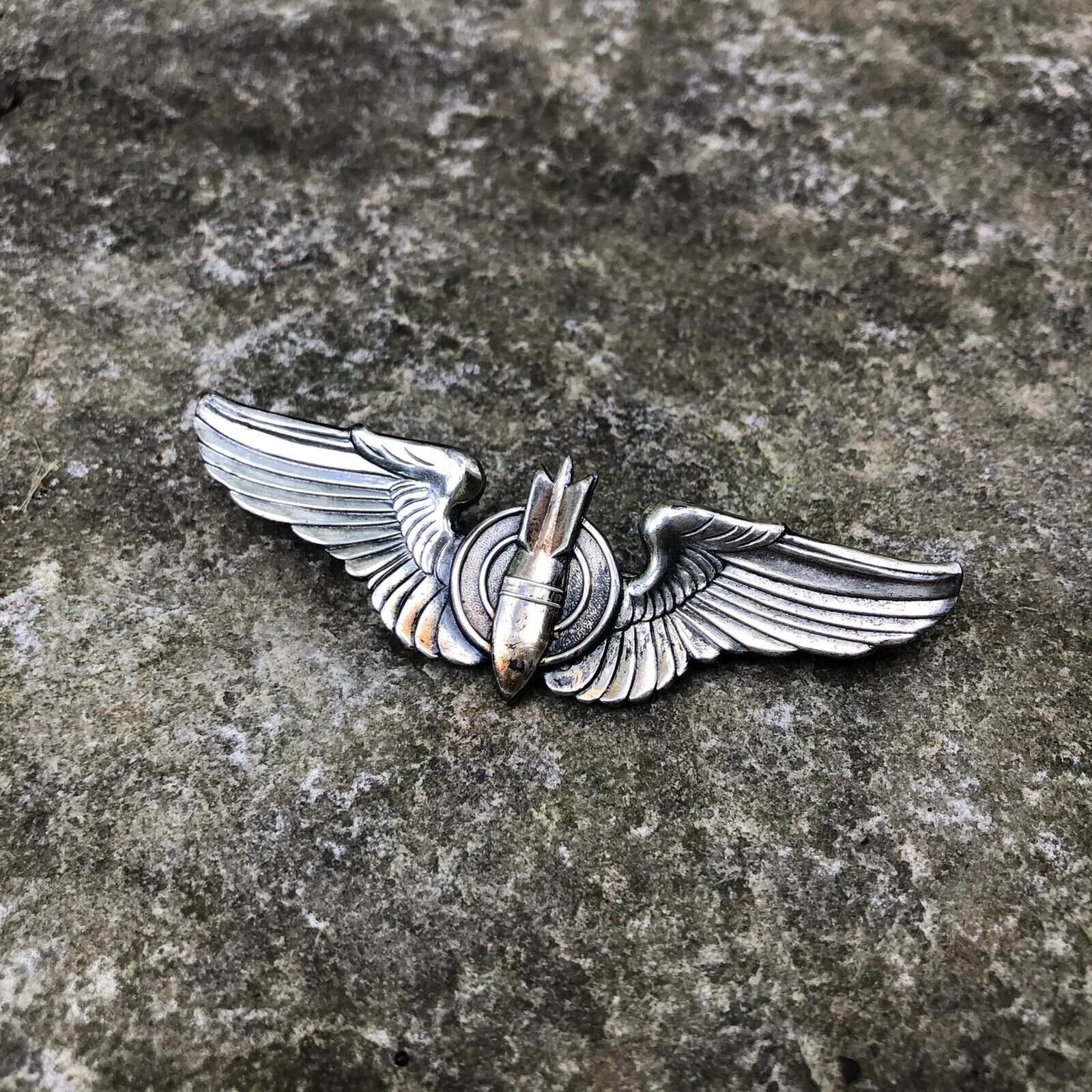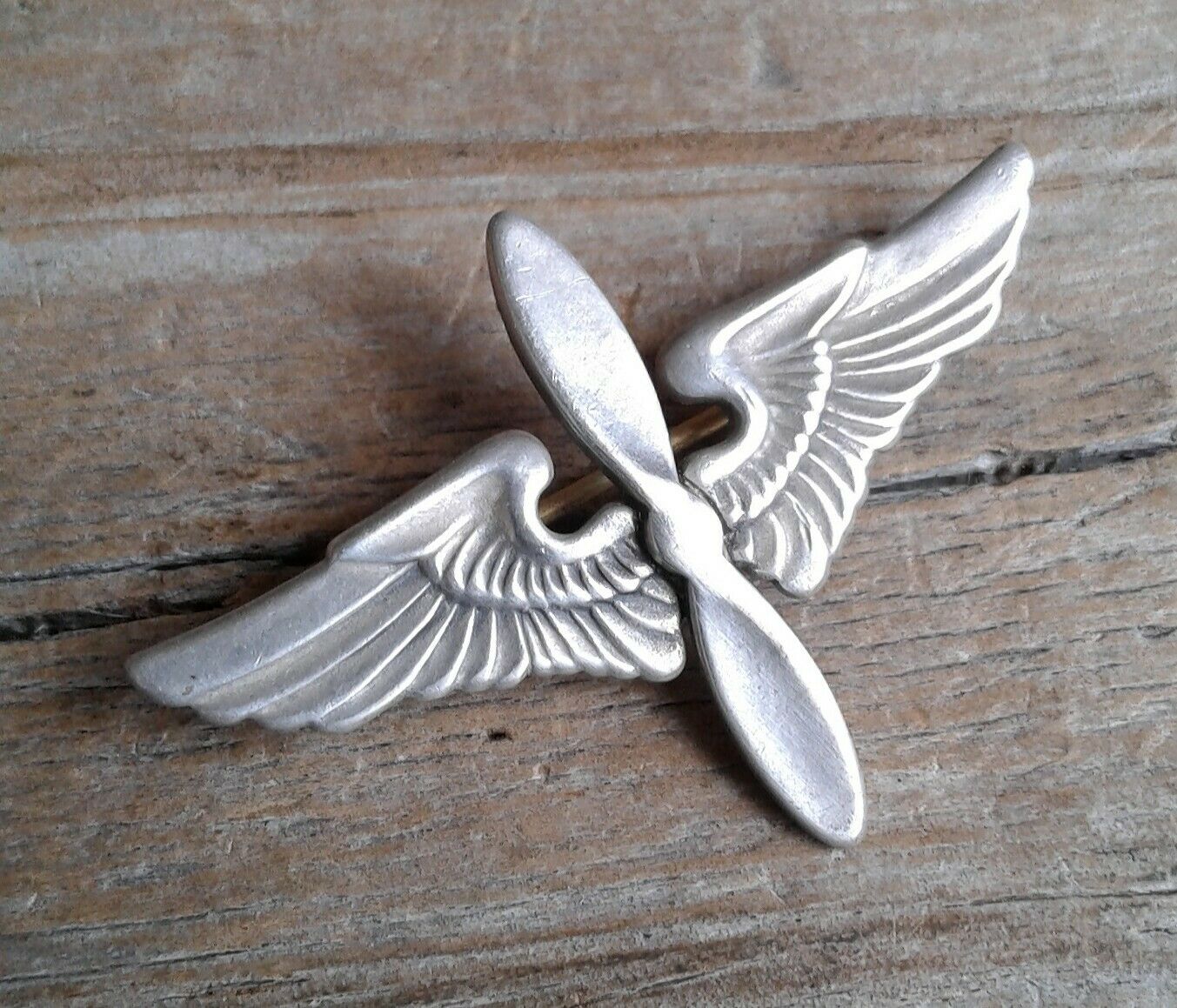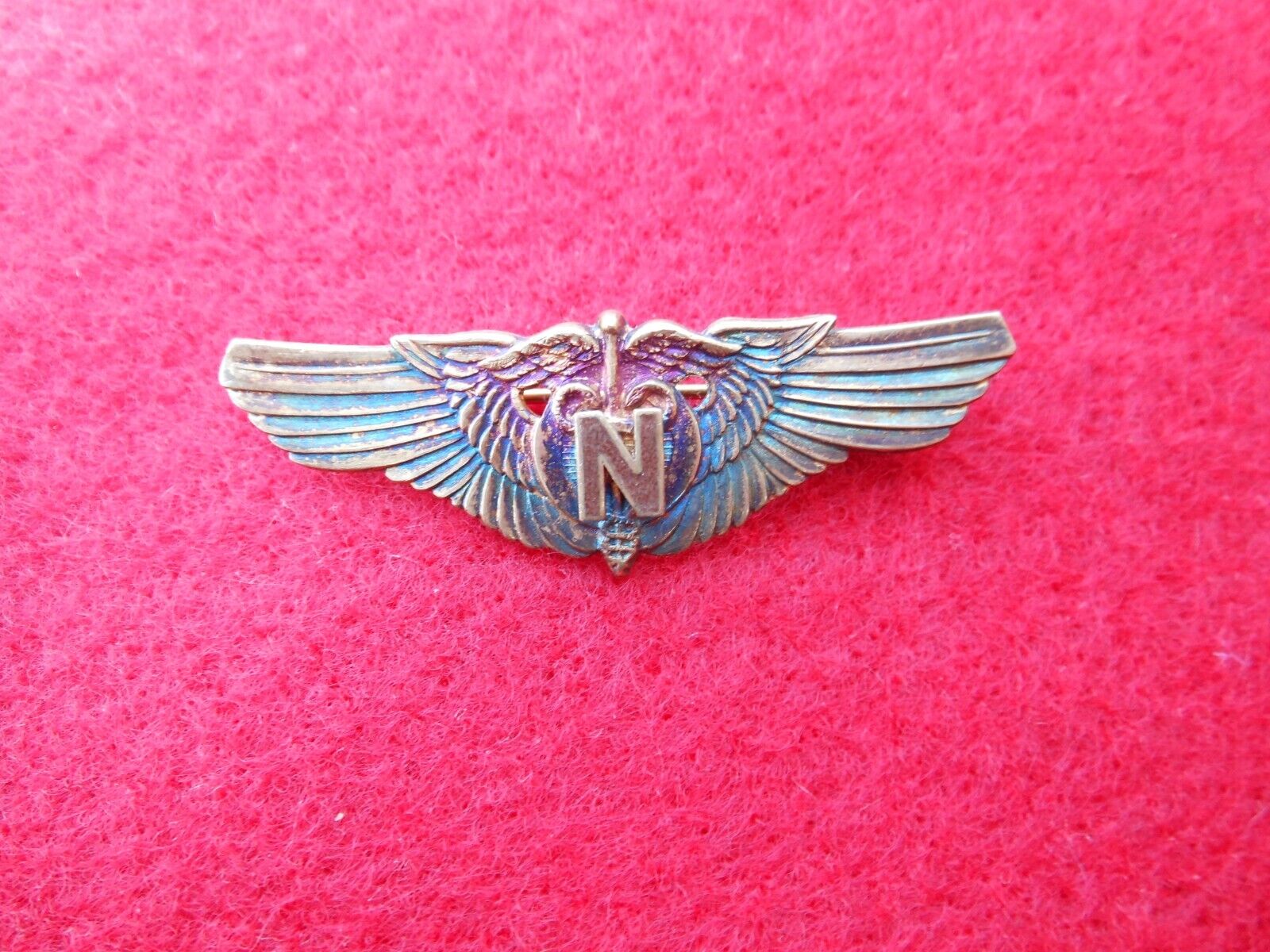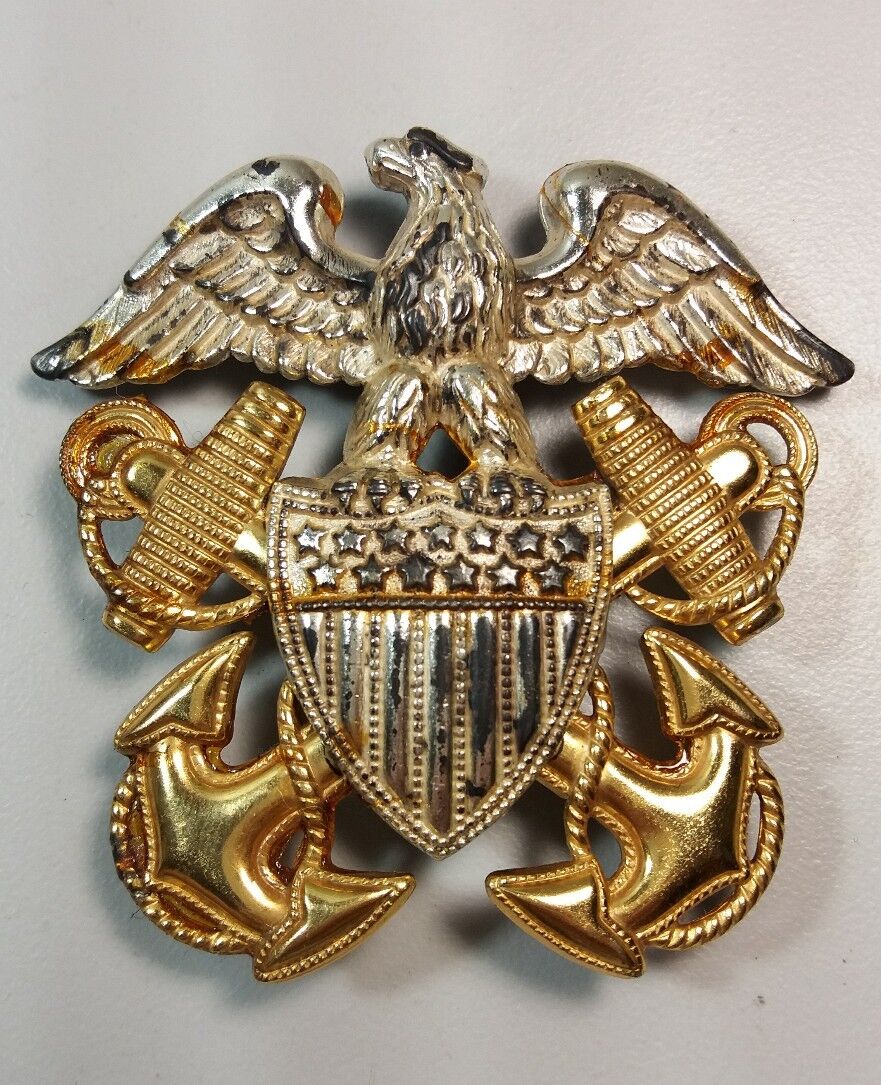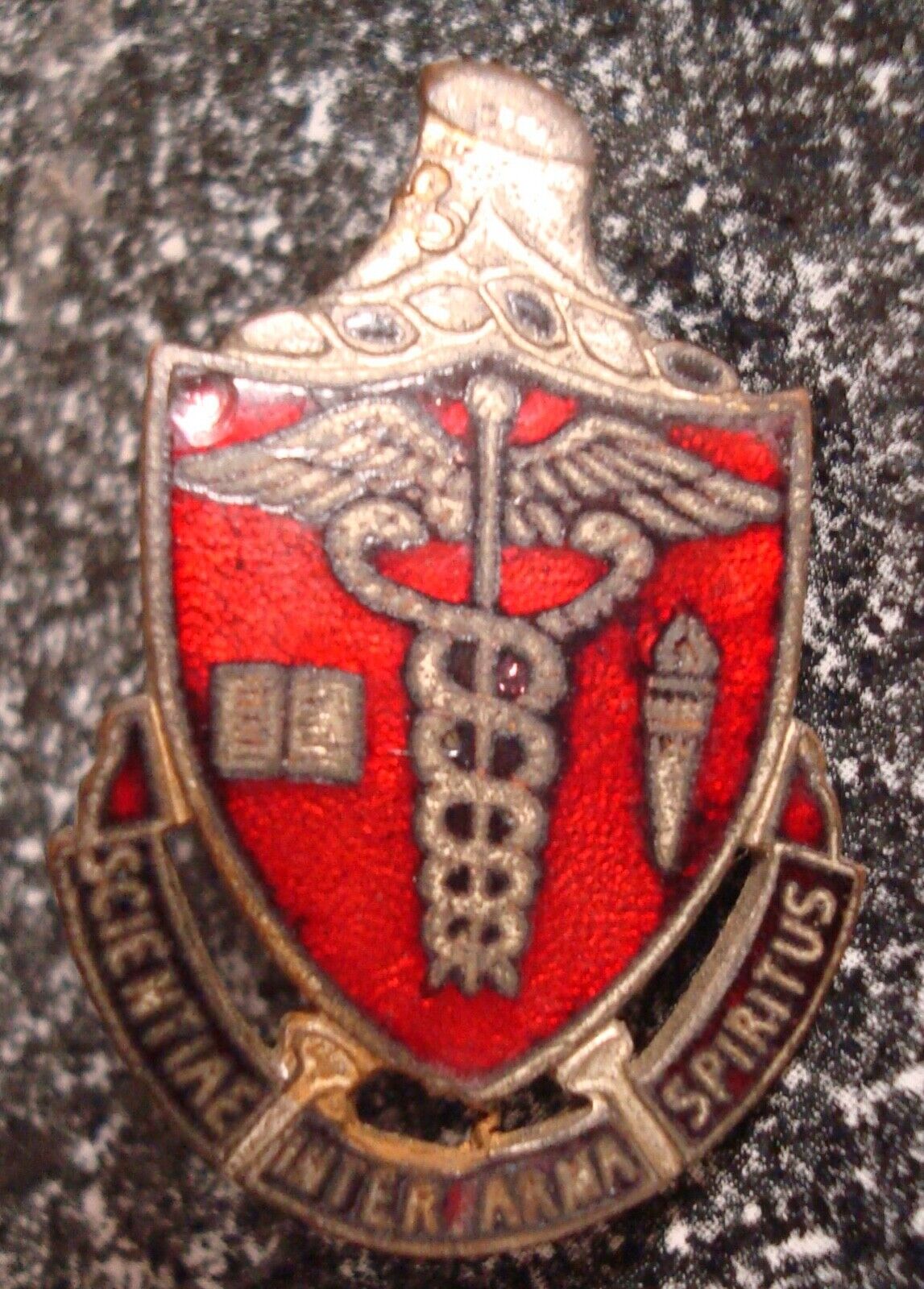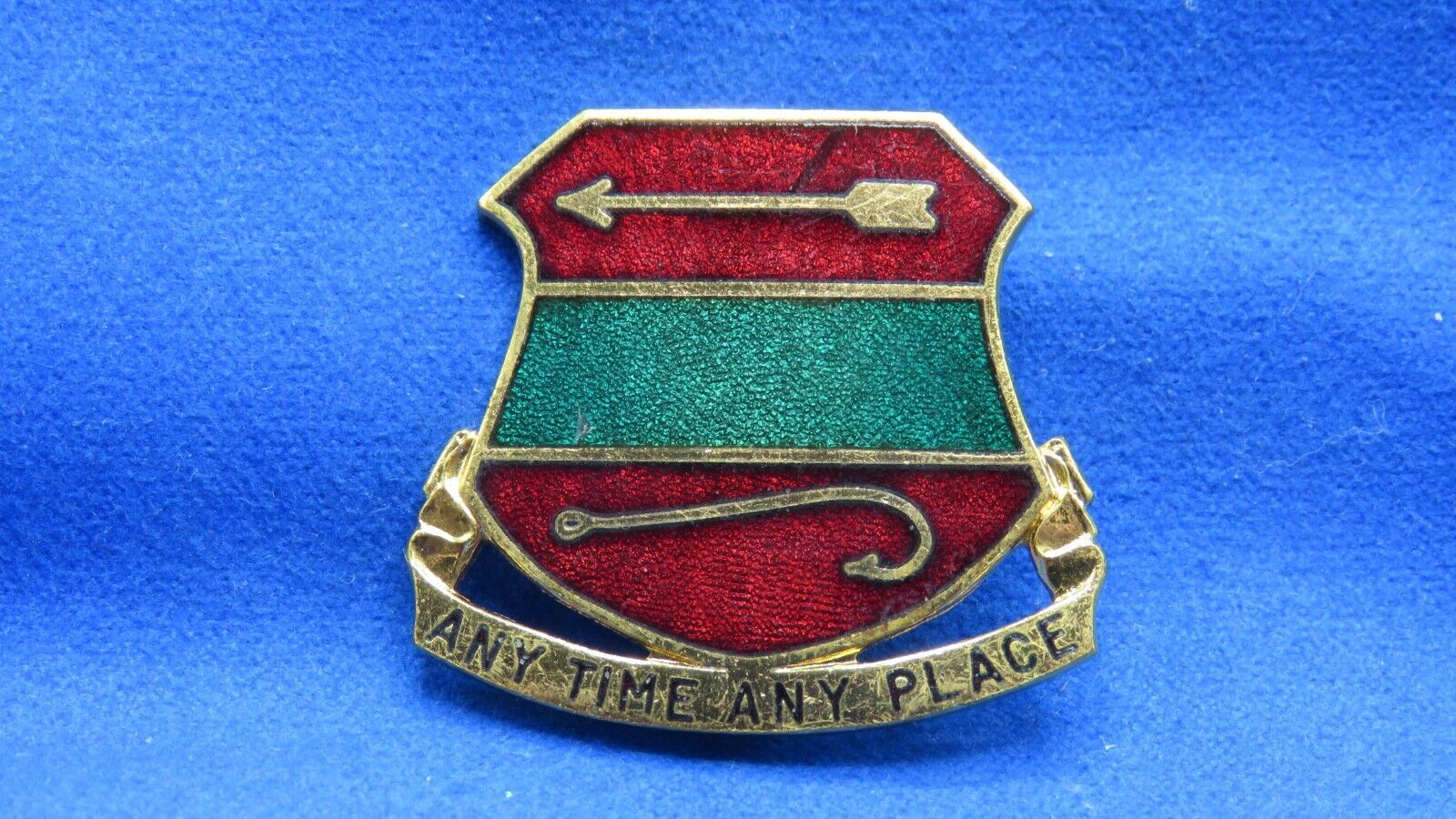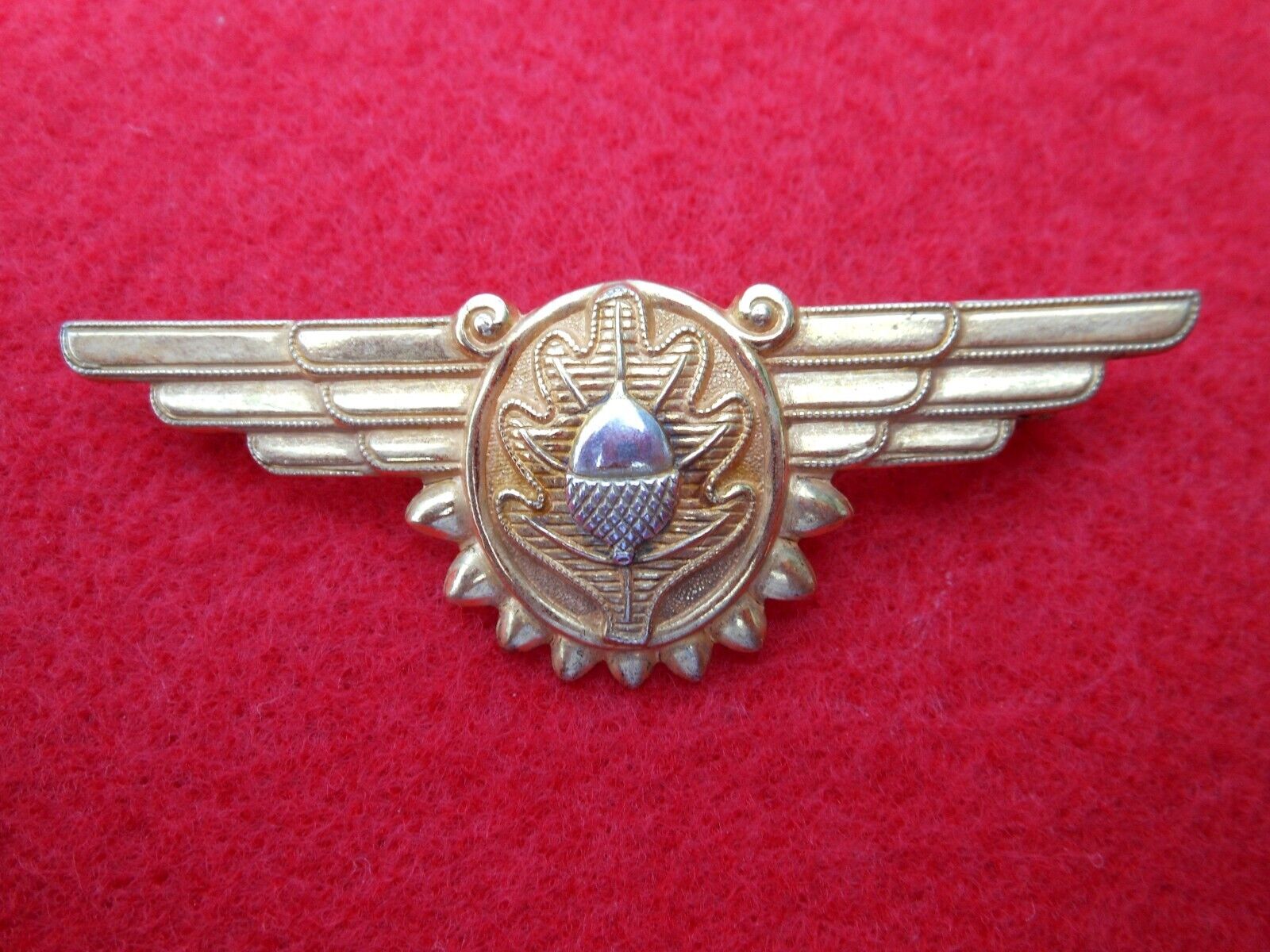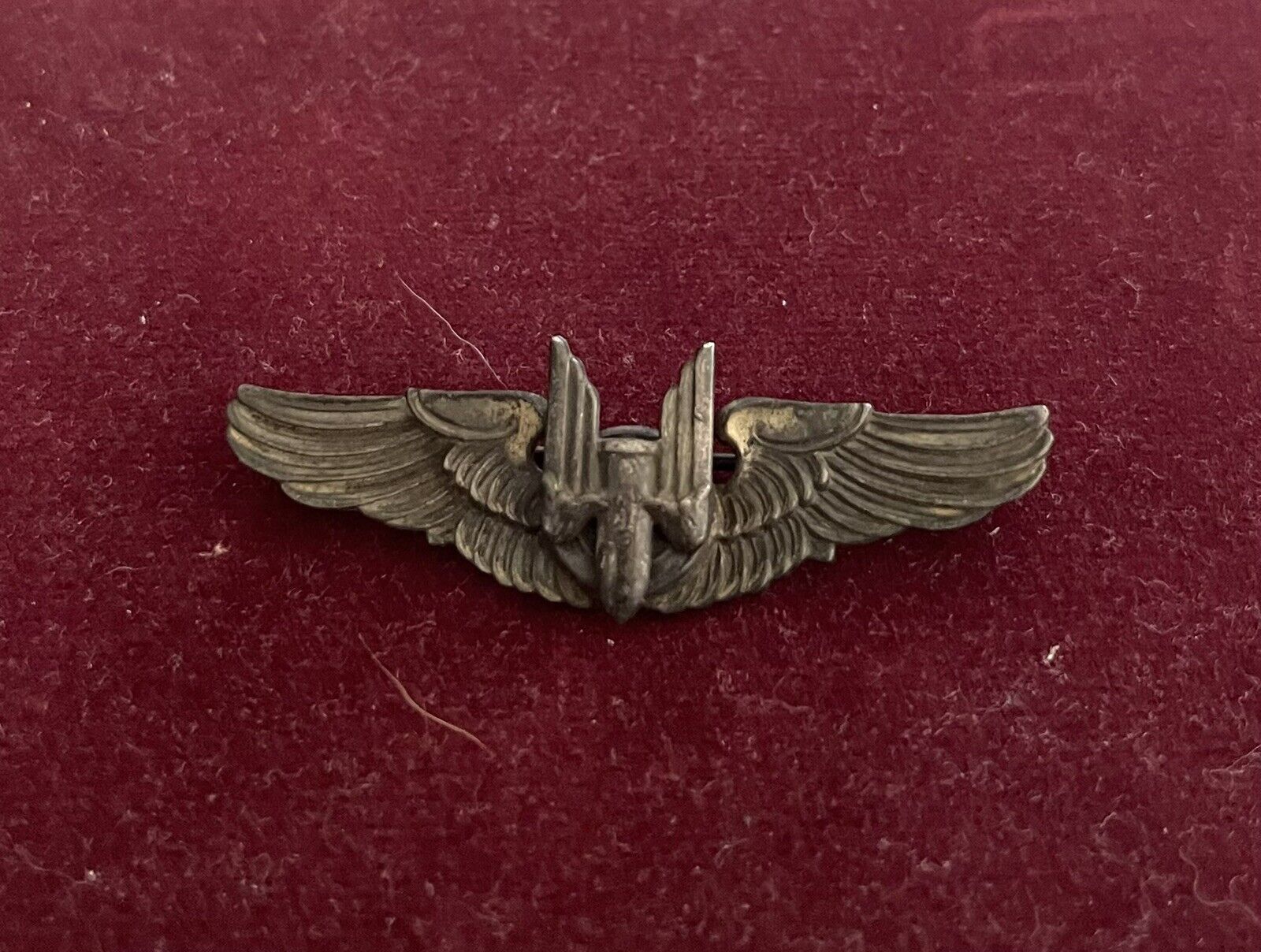-40%
WW2 US ARMY AIR CORP. WITH RIBBON RACK ---SEE STORE WE HAVE A TON OF WW2
$ 13.2
- Description
- Size Guide
Description
PLEASE FOLLOW OUR E BAY STORESEE ALL PICS
SALE
SEE OUR STORE
PLEASE READ WHOLE ADD
The
Aircrew Badge
, commonly known as
Wings
, is a qualification badge of the
United States military
that is awarded by all five branches of armed services to personnel who serve as
aircrew members
on board military aircraft. The badge is intended to recognize the training and qualifications required by aircrew of military aircraft. In order to qualify as an aircrew member and receive the Aircrew Badge, such personnel typically undergo advanced training in aircraft in-flight support roles.
United States Aircrew Badge
Type
Badge
Awarded for
Aviation service
Presented by
United States Armed Forces
Status
Currently awarded
Established
World War II
Last awarded
Ongoing
Army Precedence
Next (higher)
Any class 2 badge (e.g. Combat Medic, Expert Field Medic)
Next (lower)
Any class 4 badge (e.g. Air Assault, Airborne, Pathfinder)
[1]
The
Aircrew Badge
, commonly known as
Wings
, is a qualification badge of the
United States military
that is awarded by all five branches of armed services to personnel who serve as
aircrew members
on board military aircraft. The badge is intended to recognize the training and qualifications required by aircrew of military aircraft. In order to qualify as an aircrew member and receive the Aircrew Badge, such personnel typically undergo advanced training in aircraft in-flight support roles.
U.S. Army
[
edit
]
Aircrew Badge, World War II Army Air Forces design
Army Master Aviation Badge
The first version of the Aircrew Badge was issued by the
Army Air Forces
during the Second World War. The badge was similar in design to the
Aviator Badge
, however, and displayed an emblem denoting enlisted status on its circular shield, or
escutcheon
, centered between two wings. The emblem featured the arms of the United States of America, in clear relief generally against a horizontally lined background, on a disk with a raised rim.
Anyone trained in flight operations was authorized to wear this badge, including pilots, bombardiers, navigators, flight engineers, radio men and gunners. The badge was also awarded to certain ground personnel at the discretion of their commanding officer. Non-crewmembers eligible for the badge were individuals with flying status such as aircraft maintenance supervisors and technical inspectors. For example, aircrew badges were issued to Automatic Flight Control Equipment (A.F.C.E.) and Bombsight Shop personnel and others essential to "keep 'em flying" who flew instructional and maintenance flights but who did not actually take part in combat missions during World War II.
With the creation of the
United States Air Force
as a separate branch of service in 1947, the Army was left without an Aircrew Badge until the
Korean War
. At that time, to recognize the continued use of Army aviation, the Aircraft Crewman Badge was created. The badge was issued in three degrees: Basic, Senior, and Master. The level of seniority depended on the number of flight hours obtained and years of service in the
United States Army
.
On February 29, 2000, the Department of the Army officially changed the name of the Aircraft Crewman Badge to the Army Aviation Badge. The badge itself was not altered; however, the change was made retroactive to 1947, requiring updates to military records upon request from the military service member. This change essentially made army aircrew wings an "MOS Badge" awarded to all aviation MOS's, including non flying jobs such as Aviation Operations and Air Traffic Controllers. Thus, a crew chief who actually engages in aerial flight has no distinction from an air traffic controller because both are on flight status.
Although the Army Aviation Badge is intended for enlisted personnel, in rare cases the decoration can be awarded to officers.
For non-rated Army members who qualify for the
Astronaut Badge
, but have not yet participated in a qualifying
spaceflight
, the Army Aviation Badge may be awarded with the astronaut device appearing on the central shield.
Military history of the Philippines during World War II
From Wikipedia, the free encyclopedia
Jump to navigation
Jump to search
hide
This article has multiple issues.
Please help
improve it
or discuss these issues on the
talk page
.
(
Learn how and when to remove these template messages
)
This article
needs additional citations for
verification
.
(
August 2008
)
This article includes a list of general
references
, but it remains largely unverified because
it lacks sufficient corresponding
inline citations
.
(
November 2014
)
The
Commonwealth of the Philippines
was attacked by the
Empire of Japan
on 8 December 1941, nine hours after the
attack on Pearl Harbor
(the Philippines is on the Asian side of the international date line). Although it was governed by a semi-independent commonwealth government, the United States of America controlled the Philippines at the time and possessed important military bases there. The combined American-Filipino army was defeated in the
Battle of Bataan
and the
Battle of Corregidor
in April 1942, but
guerrilla
resistance against the Japanese continued throughout the war. Uncaptured Filipino army units, a
communist
insurgency
, and supporting American agents all played a role in the resistance. Due to the huge number of islands, the Japanese never occupied many of the smaller and more minor islands. Japanese control over the countryside and smaller towns was often tenuous at best.
In 1944, Allied forces
liberated the islands
from Japanese control in a naval invasion.
Background
[
edit
]
See also:
History of the Jews in the Philippines § American era
In September 1940,
Nazi Germany
,
Kingdom of Italy
, and
Empire of Japan
had allied under the
Tripartite Coalition
as the
Axis powers
. The United States
banned
the shipment of
aviation gasoline
to Japan in July 1940, and by 1941 shipments of
scrap iron
, steel, gasoline and other materials had practically ceased. Meanwhile, American economic support to China began to increase.
Japan and the
USSR
signed a
neutrality pact
in April 1941 and Japan increased pressure on the
French
and
Dutch
colonies in Southeast Asia to cooperate in
economic matters
. Japanese forces occupied the
naval
and
air
bases of southern
French Indochina
on 22 July 1941. The Philippines was almost completely surrounded.
General
George C. Marshall
,
US Army Chief of Staff
, stated, "Adequate reinforcements for the Philippines, at this time, would have left the United States in a position of great peril, should there be a break in the defense of Great Britain."
[1]
A campaign for independence from the US which had been ongoing since 1919 resulted on 17 January 1933 in the passage by the US Congress of the
Hare–Hawes–Cutting Act
over the veto of President
Herbert Hoover
.
[2]
The law promised Philippine independence after 10 years, but reserved several military and naval bases for the United States, as well as imposing tariffs and quotas on Philippine exports. Philippine
Senate President
Manuel L. Quezon
convinced the legislature to reject the bill. Subsequently, the
Tydings–McDuffie Act
, which eliminated provisions for US military reservations and substituted a provision for "ultimate settlement", became US law on 24 March 1934 and was accepted by the Philippine legislature on 1 May.
[3]
The impact of this on the future defense of the Philippines with the establishment was to prove disastrous. During the 10-year transition period, the
Philippine Constabulary
was vested with an ever-increasing responsibility for defending the borders of the Philippines.
[
citation needed
]
The forces of the US Army settled at around 10,000 men.
[
citation needed
]
The US Army had, however, already spent millions constructing forts and air strips throughout Luzon. This included the
harbor defenses in Manila Bay
, at Fort Mills on
Corregidor Island
and at
Grande Island
in
Subic Bay
. There were also bases at Nichols Air Station (now
Villamor Airbase
), Nielson Air Base (now
Ayala Triangle in Makati City
—
Ayala
and
Paseo de Roxas Avenues
lay over the original landing strips), at
Fort William McKinley
(now
Fort Andres Bonifacio
and the American Cemetery), Camp Murphy (now
Camp Aguinaldo
and
Camp Crame
) in
Quezon City
, Camp O'Donnell in
Tarlac
and a series of airbases and army installations in
Pampanga
including
Fort Stotsenburg
,
Clark Air Base
, as well as Camp Wallace in
La Union
, the
Naval Station in Sangley Point
,
Cavite City
, Camp Keithley in Lanao, Camp Eldridge in Los Baños, Laguna and Camp Henry T. Allen in
Baguio
. Other fields in
Tugegarao
,
Aparri
,
Isabela
,
Nueva Ecija
,
Legaspi
,
Bataan
, and
Del Monte
in
Davao
were also built using US funds prior to and during the first years of the 1935 provisional Commonwealth.
The Philippine Army
[
edit
]
Main article:
Philippine Commonwealth Army
Philippine Commonwealth Army personnel in
Davao
The date for Philippine Independence and US military withdrawal was approaching, resulting in a reduction in funds from the US military to directly support the expansion of the
Philippine Commonwealth Army
. Twelve Million US dollars were provided to the Commonwealth for the establishment of the Philippine Army in 1936. In the early years of the Commonwealth, the Philippine Army was composed of an Active Duty and a Reserve Component. The Active Duty component was the
Philippine Constabulary
, which was a para-military organization. After the outbreak of the war, this was referred to as the First Philippine Division. Many of the officers of the Philippine Army and
Philippine Army Air Corps
came from the members of the
Philippine Constabulary
and Air Constabulary.
Far Eastern Command
[
edit
]
On 25 July 1941, US Secretary of War
Henry L. Stimson
requested that US President
Franklin D. Roosevelt
issue orders calling the military forces of the Commonwealth into active service for the United States. Stimson explained, "All practical steps should be taken to increase the defensive strength of the Philippine Islands."
The following day President Roosevelt froze all Japanese assets within the United States and issued orders to absorb the forces of the Philippine Army. That same day the
War Department
created the
US Army Forces in the Far East (USAFFE)
command, with jurisdiction over the
Philippine Department
and the military forces of the Commonwealth. At the same time General
Douglas MacArthur
was recalled to active duty and designated the commander of the USAFFE.
Naval forces
[
edit
]
At the outbreak of war the
United States Navy
's
Asiatic Fleet
was stationed at
Cavite Naval Base
in
Manila Bay
. Also stationed there was the
Offshore Patrol
.
Mobilization and reinforcement
[
edit
]
MacArthur ordered the mobilization of the Philippine Army beginning on 1 September, 1941. Elements of 10 Filipino reserve divisions were to be called into the service of the United States Army by 15 December. Battalions were not organized by the time of the Japanese invasion in December. However, a force of a hundred thousand or more Filipinos was raised.
200th Coastal Artillery,
New Mexico Army National Guard
on
Luzon
On 14 August Brigadier General
Leonard T. Gerow
argued that the Philippine Department could not resist a Japanese attack. He thus recommended that the Philippines be reinforced with
anti-aircraft artillery
, modern aircraft and tanks. On 16 August, MacArthur was informed that by 5 September he could expect the
200th Coast Artillery Regiment (AA)
, the
192nd
and
194th Tank Battalions
and a company of the
17th Ordnance Battalion
.
On 5 September Marshall asked MacArthur if he wanted a
National Guard
Division, probably the
41st
. MacArthur replied that he did not need any additional divisions. He also stated, "Equipment and supplies are essential. If these steps are taken, I am confident that no such backing, the development of a completely adequate defense force will be rapid."
During September and October, in addition to the above-mentioned reinforcements, MacArthur received the 192nd Tank Battalion and 75
self-propelled
75 mm guns
.
MacArthur strove to reorganize the
Philippine Division
from a
square
into a
triangular
formation. This plan involved shipping in an American infantry regiment and or complementing Stotsenburg and allow USAFFE control of 2 American combat teams. These plans also involved the formation of four tactical commands, each of
corps
strength, along with various additional support units.
By November the War Department had approved additional reinforcements of 1,312 officers, 25 nurses and 18,047 men. The
34th Infantry Regiment
was scheduled to ship out from San Francisco on 8 December 1941. By 5 December fifty-five ships were en route from San Francisco carrying 100,000 ship-tons of cargo to the Philippines. On board were the personnel and equipment of the 26th Field Artillery Brigade, including the 147th Field Artillery, 75 mm, Truck Drawn, Regiment of the
South Dakota National Guard
; the 148th Field Artillery, 75 mm, Truck Drawn, Regiment of the
Idaho National Guard
and the 2nd Battalion of the 131st Field Artillery, 75 mm, Truck Drawn, Regiment of the
Texas National Guard
. These units were diverted to Hawaii and assigned to its defenses.
GEN MacArthur at the induction of the
Philippine Army Air Corps
When the Japanese
attack on Pearl Harbor
took place, there were several air elements en route. This included 52
A-24 Banshee
dive bombers
of the
27th Bombardment Group
, eighteen
P-40s
of the
35th Pursuit Group
, 340 tons of bombs and 9,000 drums of
aviation fuel
. There were also two light field ground echelons of the
7th Bombardment Group
, which arrived in the Philippines and were relocated to Mariveles after the evacuation of Manila. The air echelon squadrons of the 7th were en route to the Philippines and arrived in Pearl Harbor on the morning of 7 December 1941. They consisted of 9th, 463rd, 492nd, and 493d Heavy Bombardment Squadrons. The air echelon was diverted back to the US and then routed to
Java
through
Australia
.
Material and training inadequacies
[
edit
]
The Philippine Army received clothing that was of poor quality. Their rubber shoes would wear out within 2 weeks. There were shortages of nearly every kind of equipment such as blankets,
mosquito bars
, shelter halves,
entrenching tools
,
gas masks
, and
helmets
.
During August, MacArthur had requested 84,500
M1 Garand
rifles, 330
.30-caliber machine guns
, 326
.50-caliber machine-guns
, 450
37mm guns
, 217
81 mm mortars
, 288
75 mm guns
, and over 8,000 vehicles. On 18 September, he was informed that, because of
lend-lease
commitments, he would not receive most of these items. As a result, the Philippine Army was forced to continue using the old
Enfield
and
Springfield
rifles.
The shipment of supplies depended upon the US Navy's limited cargo capacity. In September, the Navy announced its intentions to convert three transports into
escort carriers
, but this was not done after MacArthur observed that the loss of three transports would delay his reinforcements by more than two months.
The army then approved requests for
105 mm howitzers
,
75 mm pack howitzers
,
75 mm guns
, .30-caliber machine guns, 37 mm guns, ten 250 ft station hospitals, one hundred and eighty sets of regimental infirmary equipment, jeeps, ambulances, trucks and sedans. By November, there were 1,100,000 tons of equipment, intended for the Philippines, piled up in US ports. Most of this never reached its destination. Meanwhile, the Navy did manage to transport 1,000,000
gallons
of gasoline to the island. Much of this fuel would be stored on the
Bataan Peninsula
.
In 1941, many Filipino units went into battle without ever having fired their weapons. Many of the troops had also never even seen an artillery piece fired. The
31st Infantry Division (PA)
signal officer was unable to establish radio communication with other units in the same camp. The commander of the Philippine 31st Infantry Division, Colonel Bluemel stated, "The enlisted men are proficient in only two things, one, when an officer appears, to yell 'attention' in a loud voice, jump up, and
salute
; two, to demand 3 meals per day."
Training and coordination were further complicated by language barriers. Enlisted Filipinos often spoke one language (such as
Bikol
or a
Visayan
language), their officers would speak another (such as
Tagalog
) and the Americans would speak English. There were some
first sergeants
and company clerks who could neither read nor write.
The Japanese decide to attack
[
edit
]
Advancing Japanese troops moving toward Manila.
See also:
Greater East Asia Co-Prosperity Sphere
and
Statism in Shōwa Japan
The Japanese viewed all the lands of Asia to be the rightful property of the Imperial Japanese Government and the Emperor.
[4]
The seizures of Korea, China and parts of Soviet Union, which had begun at the turn of the 20th century, had been taking an upswing.
[5]
The Japanese had been kept from realizing their goal of unifying or dominating the Asian lands by the presence of foreign military forces in the Philippines (United States),
Hong Kong
,
Malaysia
(United Kingdom) and the
Dutch East Indies
.
[6]
Japan had hoped that they could strike fast and hold off reinforcements long enough to broker a peace accord from a position of strength.
[7]
Central to the Japanese goals was the taking of all Asian lands.
[8]
To be successful US, UK, and Dutch forces were to be attacked simultaneously to prevent their ability to reinforce and aid their Asian possessions. Pivotal to the Japanese decision to attack was a tremendous need for crude oil as a result of
economic sanctions
imposed by the United States, the United Kingdom and the Netherlands which was weakening the
Japanese economy
. The Japanese leaders were faced with a choice: end the war in China and their plans for Asian conquest, so as to end the sanctions, or declare war on three large military forces. The current war against Britain, and the Netherlands, and the strain of providing aid by the United States to these countries was seen as an opportunity by the Japanese to extend their "rightful" place as a ruler in Asia.
[9]
The Japanese government decided to seize resources under the control of Britain, the United States and the Netherlands. Japan had already placed over ten divisions in
Formosa
(Taiwan). Japanese military planners argued that the British (and the USSR should they decide to declare war), would be unable to effectively respond to a Japanese attack, given the threat posed by the
Third Reich
.
[
citation needed
]




